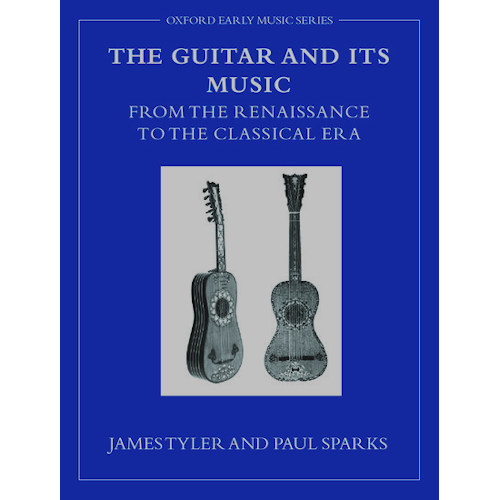Kezdőlap » Kiadványok » The Guitar and Its Music from the Renaissance to the Classical Era
James Tyler and Paul Sparks
- An authoritative guide to the history and repertory of the guitar from the Renaissance to the dawn of the Classical Era.
- New research and ideas about the development of the guitar and its music not covered in other books currently available on the market.
- James Tyler's The Early Guitar (now op) sold 1730 copies. The Early Mandolin (Tyler & Sparks) is still selling in paperback (life sales 886).
More than twenty years ago James Tyler wrote a modest introduction to the history, repertory, and playing techniques of the four- and five-course guitar. Entitled The Early Guitar: A History and Handbook (OUP 1980), this work proved valuable and enlightening not only to performers and scholars of Renaissance and Baroque guitar and lute music but also to classical guitarists. This new book, written in collaboration with Paul Sparks (their previous book for OUP, The Early Mandolin, appeared in 1989), presents new ideas and research on the history and development of the guitar and its music from the Renaissance to the dawn of the Classical era.
Tyler's systematic study of the two main guitar types found between about 1550 and 1750 focuses principally on what the sources of the music (published and manuscript) and the writings of contemporary theorists reveal about the nature of the instruments and their roles in the music making of the period. The annotated lists of primary sources, previously published in The Early Guitar but now revised and expanded, constitute the most comprehensive bibliography of Baroque guitar music to date. His appendices of performance practice information should also prove indispensable to performers and scholars alike.
Paul Sparks also breaks new ground, offering an extensive study of a period in the guitar's history—notably c.1759-c.1800—which the standard histories usually dismiss in a few short paragraphs. Far from being a dormant instrument at this time, the guitar is shown to have been central to music-making in France, Italy, the Iberian Peninsula, and South America. Sparks provides a wealth of information about players, composers, instruments, and surviving compositions from this neglected but important period, and he examines how the five-course guitar gradually gave way to the six-string instrument, a process that occurred in very different ways (and at different times) in France, Italy, Spain, Germany, and Britain.
Tartalom:
Dedication
Preface
List of Illustrations
List of Tables
List of Musical Examples
List of Abbreviations
Acknowledgements
Part I: The Guitar in the Sixteenth Century, James Tyler
1.:Spain: La Guitarra de quatro ordenes
2.:France: The Creation of the Repertory
3.:England: '... yused of gentilmen, and of the best sort ...'
4.:Italy: La Chitarra da sette corde
5.:Italy: The Role of the Guitar in the Rise of Monody
Part II: The Spanish Guitar (c.1600-c.1750), James Tyler
6.:Italy: The Creation of the Repertory
7.:France: Les Guitarristes Royals
8.:1. England
2. The Low Countries
3. Scandinavia
4. Germany and the Austrian Empire
9.:Spain, Portugal, and the New World
Appendix I. A Brief Guide to Reading and Interpreting Baroque Guitar Tablatures
Appendix II. Sources of Specific Information on the Tuning and Stringing of the Five-course Guitar
Appendix III. The Mandora
Part III: The Origins of the Classical Guitar, Paul Sparks
10.:1750-69: The Emergence of the Six-Course Guitar
1. Spain, Portugal, and South America
2. France
3. Britain
11.:1770-89: The First Six-String Guitars
1. A Short History of String Making
2. Spain, South America, and Portugal
3. Italy
4. France
5. England. Germany, and Austria
12.:1790 to the Early 1800s: The Triumph of the Six-String Guitar
1. Spain and Portugal
2. Britain
3. Italy
4. France
5. Germany, Austria, and Elsewhere
13.:The Guitar 1750-c.1800: Practical Information
1. The Instrument
2. Strings
3. Playing Positions
4. Specialist Techniques and Ornamentation
Appendix IV: Primary Sources (1750-c. 1800)
1.:Paris - Instrumental Music (Published)
2.:Paris - Songs with Guitar Accompaniment (Published)
3.:Guitar Methods (Published and Manuscript)
4.:Non-Parisian Guitar Music (Published and Manuscript)
Appendix V: Pieces for Guitar (c.1750-c.!800)
Bibliography of Secondary Sources
Index
